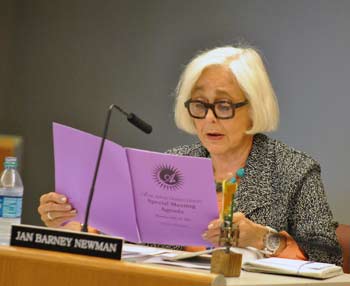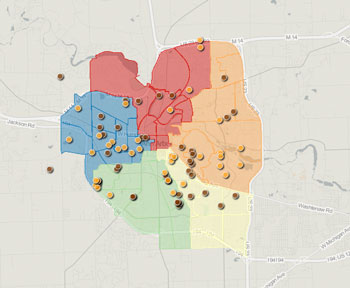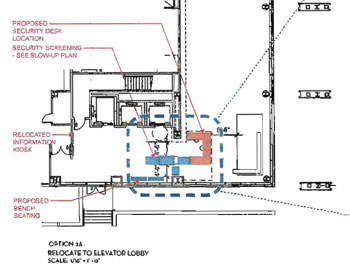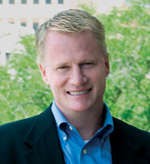Ann Arbor public art commission meeting (July 25, 2012): A push for greater public engagement was a theme throughout the July AAPAC meeting, with John Kotarski – one of the newer commissioners – proposing several ways to get more public input.
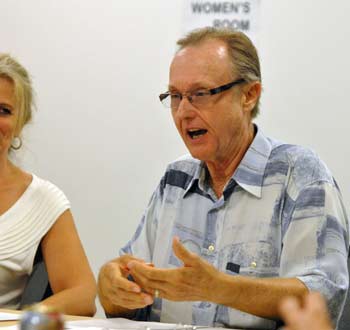
Ann Arbor public art commissioner John Kotarski at AAPAC's July 25, 2012 meeting. (Photos by the writer.)
At Kotarski’s suggestion, commissioners considered three items related to AAPAC meetings: (1) adding a second opportunity for public commentary; (2) changing its meeting times; and (3) alternating the locations of its meetings. Kotarski also raised the possibility of recording the proceedings to be broadcast on Community Television Network (CTN).
The additional public commentary – offering speakers a second three-minute slot at the end of each meeting – was ultimately approved. Less enthusiasm was expressed for pushing back meeting times to later in the day. AAPAC meetings currently start at 4:30 p.m. on the fourth Wednesday of each month, and are held in the basement conference room at city hall. Kotarski proposed moving the meetings to different locations throughout the city, such as schools or other public sites, to make it easier for more people to attend. Commissioners had reservations about that idea too, nor was there much support voiced for a suggestion to record the meetings for broadcast by CTN. Kotarski plans to bring a specific proposal on these items to an upcoming meeting.
Another proposal by Kotarski – to include support for local sourcing as part of AAPAC’s strategic plan – was rejected by other commissioners. Some commissioners felt the idea didn’t fit into a strategic plan, because it was not an action item. Others questioned whether local sourcing of art projects was within AAPAC’s purview, because the commission doesn’t have authority over the city’s purchasing policies. They’ve also been advised that they can’t put geographic constraints on their selection of artists, and felt this would apply to sourcing, too.
Ultimately a four-year strategic plan was approved without Kotarski’s revision. The plan’s goals, in summary form, are: (1) increasing the number of public art pieces throughout the city; (2) diversifying the public engagement and participation in selecting public art; (3) increasing the public’s support and appreciation for public art through PR efforts; and (5) pursuing private funding for public art. More detailed objectives are provided for each of the goals.
Kotarski also was unsuccessful in convincing other commissioners to support an endorsement policy for non-city-funded art projects. AAPAC passed a resolution stating that the commission would not make endorsements – and Kotarski cast the lone dissenting vote. In a separate item, Kotarski joined his colleagues in a unanimous vote to establish an SOQ (statement of qualifications) process that creates an artist registry/database. The intent is to streamline the selection of artists for future projects.
During the July 25 meeting, commissioners were updated on several ongoing projects, including a follow-up on concerns raised last month about the Dreiseitl installation in front of city hall, artwork at a planned rain garden at Kingsley & First, and the status of security checkpoints allowing access to a hanging sculpture in the Justice Center lobby.
There were no updates for some projects because those projects are still being reviewed by the city attorney’s office. Several commissioners expressed frustration at the length of time these reviews are taking. One commissioner wondered what tools AAPAC can use to influence the process, perhaps by appealing to another level within the city administration. AAPAC chair Marsha Chamberlin agreed to draft a letter on the issue, and to discuss it with city councilmember Tony Derezinski, who serves on the commission but has not attended its June or July monthly meetings.
Action was deferred on proposed projects for public art at two locations: (1) a plaza next to the Forest Avenue parking structure near South University; and (2) a future roundabout at Ellsworth and South State. Commissioners wanted more time to visit those sites. They also debated whether to postpone action until task forces are formed to represent four quadrants of the city – it’s part of a new approach they’re planning to take to help guide the selection of projects and ensure that all parts of the city are represented.
The commission is likely to get more advance notice of possible projects, as Aaron Seagraves – the city’s public art administrator – will now be attending meetings of the capital improvements plan (CIP) team. The CIP is relevant to the art commission because funding for the Percent for Art program comes from the city’s capital projects – with 1% of each capital project, up to a cap of $250,000 per project, being set aside for public art. The CIP also indicates which major projects are on the horizon that might incorporate public art. By identifying such projects, AAPAC can start planning the public art component as early as possible, as part of the project’s design, rather than as an add-on. [Full Story]





